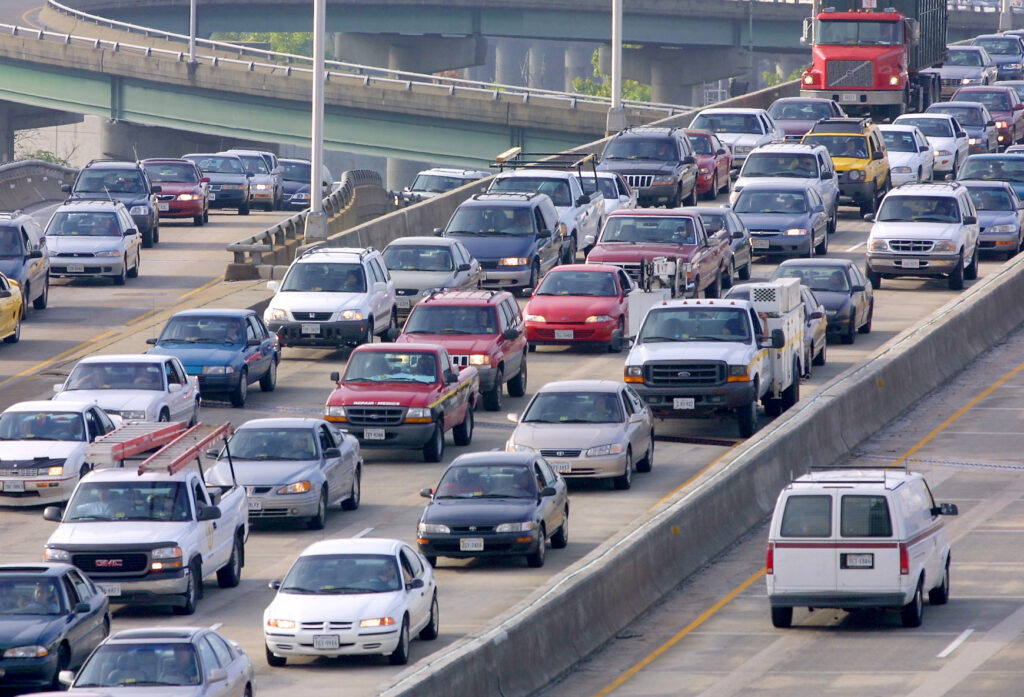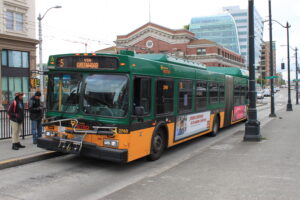Four ways states and the Biden administration can curb transportation pollution
Last month, the US Department of Transportation (USDOT) proposed a new rule that will require states to measure and set goals for reducing greenhouse gas emissions associated with highways. This is a critical tool to foster accountability and steer infrastructure investments toward better climate outcomes. It’s essential for the USDOT to finalize this rule and for states to lead the way in realizing its full potential.
This post was written in partnership with Evergreen Action.

The Greenhouse Gas Emissions Measure (GGEM), would require state DOTs and metropolitan planning organizations (MPOs) to measure and reduce greenhouse gas emissions tied to highways on the National Highway System (i.e. Interstates and US Routes). This proposal is a key action that Evergreen, Transportation for America, and other advocates have called for. Because the transportation sector emits more greenhouse gas pollution than any other sector of the American economy, data collected from this measure will be a vital tool to support investments in alternative transportation modes, better protect disadvantaged communities, and advance President Biden’s climate goals.
Following the enactment of the critical climate and infrastructure investments contained in the Inflation Reduction Act (IRA) and the Infrastructure Investment & Jobs Act (IIJA), Congress and the Biden administration must each play a role in ensuring that these resources are implemented effectively and equitably. At the same time, increased ambition at the state level and bold executive action are essential in order to attain further emissions reductions. New federal rules that enable states to push the envelope are needed to tackle the largest sources of climate pollution, and that includes our transportation sector.
So what is this rule all about?
In 2012 Congress passed the Moving Ahead for Progress in the 21st Century Act (MAP-21), a two-year transportation authorization bill following nearly 3 years of stop-gap extensions. MAP-21 represented a tentative step towards accountability for the billions of dollars the federal government allocates to states every year for transportation, by codifying seven different performance categories for federal highway programs. The Federal Highway Administration (FHWA) created performance measures and subsequently required state DOTs to set performance targets aligned with these goals.
In 2017, the Obama administration proposed requiring states to measure greenhouse gas pollution from their surface transportation systems (i.e. roads, highways, transit, etc) for the first time, consistent with the goal of environmental sustainability established by MAP-21. Many construction industry stakeholders opposed it, likely viewing it as a threat to business as usual. Unsurprisingly, the Trump administration sided with industry and repealed the measure before it was fully implemented.
But a new and improved version of this measure is back, under the Biden administration. In early July, the FHWA proposed a new draft rule for a GGEM that would establish a method for state DOTs to calculate greenhouse gas emissions. Rather than a one-size-fits-all target set by the USDOT, states would be permitted to set their own unique declining targets that collectively lead the US towards net-zero emissions by 2050. Critically, the draft GGEM rule would require these targets to continuously decrease, to cut emissions over time in each state. The proposal is a big step forward from the status quo, but still limited in scope. For example, states face no penalties for failing to meet their established targets.
Here are the four actions the Biden administration and state DOTs must take for this proposal to be successful:
1. The Biden administration must finalize a strong performance measure rule ASAP
While the IIJA is not a transformative climate bill, states have a wide berth in deciding how to allocate formula funding under IIJA. The law also establishes new categories of climate mitigation funding, like the Carbon Reduction Program, and expands the kinds of investments eligible under legacy programs like the Congestion Mitigation and Air Quality Improvement Program. In short, governors and state governments will determine, through the decisions they make about what to build, whether or not the IIJA leads to reductions in climate pollution. However, without the proposed rule, the public has no way to hold states accountable for reducing emissions with the windfall of infrastructure money from the IIJA.
Right now, the FHWA has opened a public comment period for the proposed rule through October 13, 2022. Just like in 2017, this rule is already meeting fierce resistance, from both industry and Senate Republicans.
Some stakeholders are falsely claiming that this proposed rulemaking is outside the scope of the performance measures set forth by Congress in MAP-21. Many congressional leaders who were involved in passing that legislation have set the record straight, emphasizing that this proposal will “fulfill the original congressional intent…” There is plenty of flexibility for states built into the existing rule and the Biden administration must finalize a strong performance measure.
2. The Biden administration should factor in state performance when evaluating other competitive grant programs, and FHWA should improve its performance dashboard
Although most federal transportation funding is formula-based, the USDOT can influence policy significantly through discretionary funds like the Secretary’s RAISE grants or the Reconnecting Communities Program. To ensure the greenhouse gas performance measure doesn’t just “sit on the shelf,” the department should assess the relative ambitions of state greenhouse gas reduction targets and progress states achieve as it awards competitive funds. The Biden administration should also incorporate implementation of the measure into criteria for new programs created by the Inflation Reduction Act, including the Neighborhood Access and Equity grant program and the EPA’s new Climate Pollution Reduction grants.
Moreover, because of the non-binding nature of the performance measure proposed, it’s essential that the emissions data and targets of each state are properly advertised and disseminated. This will allow the data to facilitate increased accountability. Right now, the FHWA’s dashboard for state performance data is buried on its website and the information is not frequently discussed or publicized. Going forward, the FHWA and the Office of the Secretary should reinvigorate the dashboard and regularly update stakeholders and the broader public regarding the progress states are making in setting and reaching their declining targets.
3. States should incorporate performance measures in state policy and go beyond USDOT’s proposal

Because the targets required by the draft GGEM would be non-binding, it will ultimately be up to states to make their greenhouse gas targets meaningful in a local context. Going forward, states must better prioritize climate in transportation policy and funding decisions. Many states are already measuring greenhouse gas pollution in the transportation sector in some capacity and tailoring their long-range plans, short-term capital plans, and overall investment strategies accordingly. The following model policies should be considered as states move forward with accessing IIJA/IRA funding and implementing the performance measure.
Colorado: The Colorado Transportation Commission recently approved a new rule that will set mandatory greenhouse gas reduction goals for each MPO. These goals must be incorporated into investments identified in each region’s short and long-term transportation plans. The regional goals can be achieved by reprioritizing planned projects or investing in new mitigation strategies. In most cases, this will mean shifting investments away from the construction and expansion of highways and towards public transit and improvements to pedestrian and bicycle infrastructure.
Minnesota: Even as demand for electric vehicles has grown and the Biden administration acts to raise fuel efficiency standards for cars, vehicle miles traveled (VMT) in the United States continue to increase. States have a tremendous opportunity to act where the federal government has not and institute policies that tackle auto dependency. Minnesota recently adopted a statewide goal to reduce VMT statewide by 20 percent by 2050. More states need to look beyond electric vehicles and work towards shifting travel towards the most sustainable and equitable modes of transportation.
Washington: Washington State DOT is not waiting for the federal government and has already implemented a performance measure for greenhouse gas pollution associated with the National Highway System infrastructure inside the state. Emissions and targets are reported to the federal government biennially. Earlier this year, Washington also enacted Move Ahead Washington, a significant transportation funding package that invests heavily in public transportation and other sustainable modes aimed at reducing car travel.
4. States should implement an equity-first approach to meeting targets
States will have significant discretion when deciding how and where to spend transportation-related IIJA funds, and they should ensure they deploy federal funds with a focus on communities that are already impacted by transportation planning and pollution. Black, Brown, Indigenous, and low-income communities suffer the most from vehicle pollution and are historically least likely to receive government investments. By prioritizing these underserved and overburdened communities, states can ensure they are supporting their most vulnerable populations while reducing pollution.
Additionally, state policymakers need to pay careful attention to wealth disparities between white users of the transportation system and people of color, which impact both mode choice and job access. States should consider new incentives for used electric vehicles to supplement the credit for used vehicles contained in the Inflation Reduction Act, and also need to take significant steps to build out networks of Complete Streets and make public transportation more reliable and affordable. Finally, state departments of transportation should prioritize investments that begin repairing past racist policy decisions that were meant to intentionally divide neighborhoods.
Key takeaway
The transportation sector is the largest source of greenhouse gas pollution in the United States. Because most transportation investment decisions are made at the state level, the USDOT’s new Greenhouse Gas Emissions Measure is a critical tool to foster accountability and steer infrastructure investments away from expanding highways and towards vehicle electrification, public transportation, and improvements for other sustainable modes of travel like biking and walking. It’s essential for the USDOT to finalize this rule and for states to lead the way in realizing its full potential.




















2 Comments